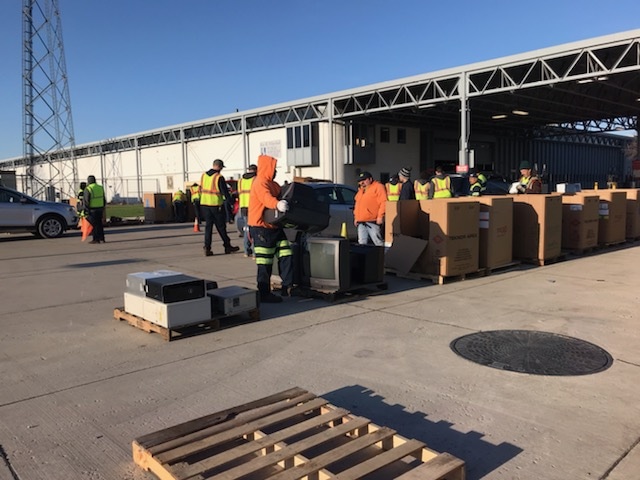
What is E-Waste?
Today, though, a growing amount of e-waste is not considered to be products that have stopped working or become obsolete.
Technological advances are coming at us at such a dizzying speed that a lot of electronic devices that still work fine are the ones considered obsolete.
Think of the many VCR players that got replaced when the DVD player hit the market, and now the DVD players getting replaced by Blu-ray players. If a product is powered electronically and someone thinks they can create a better version, that contributes to e-waste.
And we care about this because, for years now, unwanted electronic devices have been filling landfills across the globe. In the U.S. alone, the Environmental Protection Agency estimates that up to 60 million metric tons of e-waste end up in landfills every year.
E-waste Hides Toxic Materials
While above ground, modern electronics are safe to use and be around. However, most electronics contain some form of toxic materials, including beryllium, cadmium, mercury, and lead, which pose serious environmental risks to our soil, water, air, and wildlife.
When E-waste gets buried at a landfill, it can dissolve in microscopic traces into the gross sludge that permeates at the landfill. Eventually, these traces of toxic materials pool into the ground below the landfill. This is known as leaching.
The more E-waste and metals at the landfill, the more of these trace toxic materials show up in the groundwater.
Leeching Poisons Nearby Water
The problem is that there is so, so much E-waste that the trace amounts have ballooned over the years. That toxic water under the landfill doesn’t stop below the landfill. It continues to the groundwater and the sources to all the freshwater in the surrounding area.
Not only is this bad for anyone using a natural well, but it hurts the nearby wildlife. That, in turn, causes the wildlife to get sick from lead, arsenic, cadmium, and other metal poisonings due to the high concentration of these minerals.
Mining For New Metals Causes This Too
Not only is this a problem for E-waste in landfills, but this is a side effect of mining for new sources of metal too.
Having an environmentally-friendly source of recycled metal is better for the environment than a company digging up new sources of ore. Every time you recycle your electronics, you are preventing your E-waste from leaching toxic metals into your groundwater. But you’re also preventing it from happing at a mine somewhere else.
How You Can Help
Fortunately, there’s a proven solution. The recycling of e-waste serves a lot of useful purposes. For instance, include protecting human and environmental health by keeping those devices out of landfills. Or recovering the parts within the devices that still have value, and providing manufacturers with recycled metals that can be used to make new products.
Virtually all electronic waste contains some form of recyclable material. That includes materials like plastic, glass, and metals, which is why they may be considered “junk” or “obsolete” to consumers but still serve an essential purpose. It’s ironic, in some ways, that these devices are called “e-waste,” since they’re not waste at all. But in far too many instances, they are thrown away.
With electronic recyclers like GLEC, we have a solution. The challenge is getting recycling rates, still stubbornly low, to increase.
E-waste Problems
The definition of e-waste is likely to keep expanding. In an era of rapid technological advancement, more and more highly sophisticated electronic goods are being invented and manufactured. Just think of the concept of the “smart home.” It’s easy to recognize how many electronic devices can now do everything from offer security to turning lights on and off, to having fresh coffee ready before we wake up.
Unfortunately, a skyrocketing amount of e-waste is being written off by owners as junk. There’s no more significant example of that than computers, laptops, and smartphones.
New models arrive even as the current one appears to be working just fine. Despite that, the latest version always provides additional features that make it seem too enticing to resist.
So in answer to the question, “What is e-waste?” a good response today might be, “It depends.”
The technology innovators continue to create electric devices designed to make our lives easier and more convenient in every conceivable way. Still, we seem all too susceptible to quickly pitching the machines we already have. It doesn’t matter how satisfied we’ve been with them up until now.
How Did We Get to This Point?

In 1976, Congress first addressed the issue of hazardous waste disposal with the passage of the Resource Conservation and Recovery Act. This act sets standards for protecting human health and the natural environment from the potential hazards of waste disposal.
One of the goals of the law was to ensure the management of waste in an environmentally sound manner.
The next major step was the Basel Convention in March 1989, an international treaty designed to reduce the movements of hazardous waste between nations and prevent the transfer of hazardous waste from developed to less-developed countries.
One thing that’s grown significantly since then has been the e-waste recycling industry. This industry has the most proven way of keeping e-waste out of landfills or from being burned in incinerators.
The recycling industry has been devoted to taking reusable parts from discarded electronic devices and recycling them for the benefit of local businesses and manufacturers.
As the amount of e-waste keeps rising, so has this industry, which today creates hundreds of thousands of jobs across the world by recycling the electronics we no longer want.
So much of what’s in e-waste still has value. Circuit boards contain valuable metals like silver, tin, gold, palladium, and copper.
Hard drives can be shredded and processed into aluminum ingots for use in the automotive industry.
In 1991, the first electronic waste recycling system was implemented in Switzerland with the introduction of a system to collect refrigerators. Other electric and electronic devices got added to the system in later years.
A decade later, the European Union implemented a similar system called the Waste Electrical and Electronic Equipment Directive to establish e-waste recycling requirements for member nations.
In the U.S., there are no federal laws governing e-waste, although 25 states have their own e-waste rules.
Is “e-waste” clearly defined?
The term “e-waste” usually applies to consumer and business electronic equipment that’s no longer wanted, but that contains material that renders them hazardous when placed in landfills.
But we know that every year, the list of e-waste items gets longer – and longer. In January, when the Consumer Electronics Show opened in Las Vegas, there was a steady stream of new product announcements, like the one by Audio Technica. A Japanese company that unveiled two new wood-based, belt-drive turntables, the AT-LPW40TN, and AT-LPW30TK, created to deliver high-fidelity audio performances.
At the same show, TCL Communication debuted a brand new Alcatel smartphone with a Full View Display.
Other new devices on the market today include FXD, which can instantly diagnose car problems when your “Check Engine Light” comes on. Or, the KeySmart Pro, which is an organizer providing a better way to organize and carry your keys. And HeatBuddy, an energy-efficient plug-in heater for any room in the house, that’s small and compact.
And new ideas keep coming. And each one likely means something else that we’ve relied on in the past will become “obsolete.”
